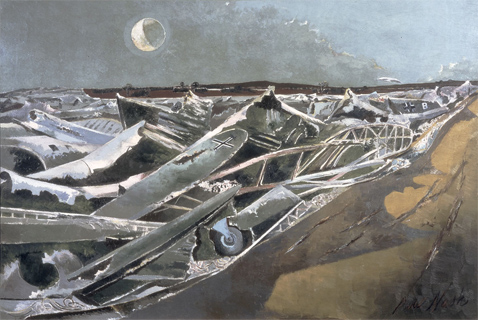Today is Battle of Britain Memorial Day so this week’s choice of picture is Paul Nash’s Totes meer (Dead sea). It was painted in 1941 following the painter’s appointment as an Official War Artist and was inspired by the sight of twisted wreckage from German fighter planes at an aircraft dump in Cowley.
The archives of the Imperial War Museum contain a letter from Nash to the Secretary of the War Artists Advisory Committee, about the genesis of his bleak memento mori:
“The thing looked to me, suddenly, like a great inundating sea. You might feel under certain circumstances – a moonlight night for instance – this is a vast tide moving across the fields, the breakers rearing up and crashing on the plain. And then, no; nothing moves, it is not water or even ice, it is something static and dead. It is metal piled up, wreckage. It is hundreds and hundreds of flying creatures which invaded these shores (how many Nazi planes have been shot down or otherwise wrecked in this country since they first invaded?). Well, here they are, or some of them. By moonlight, the waning moon, one could swear they began to move and twist and turn as they did in the air. A sort of rigor mortis? No, they are quite dead and still. The only moving creature is the white owl flying low over the bodies of the other predatory creatures, raking the shadows for rats and voles…”
Nash’s lengthy apologia for his own work may have been provoked by the knowledge that some members of the War Artists Advisory Committee regarded his painting as too morbid and obscure. The artist could count on the enlightened support of Dickey, as well as that of Kenneth Clark; but Air Commodore Peake,...


